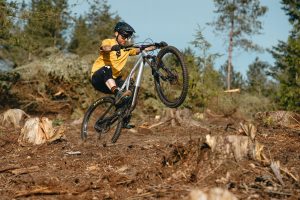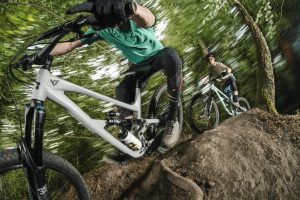Blurring the lines between trail and enduro, this boutique beauty is can also be set up with 160mm of travel.
Salsa Blackthorn Carbon first ride review
Best known for its gravel and adventure bikes, Salsa has also spent years blending secret sauces for top-tier mountain bikes. The stealthy Blackthorn is its current 140mm travel rig that’s designed around a 160mm fork, modern angles, and a go-anywhere, ride-anything philosophy. If money is no object, and you want something a little different from the mainstream, it definitely stacks up against the best full-suspension trail bikes on the market.
Need to know
- Salsa’s do-it-all 140mm carbon trail bike rolls on 29in wheels and is designed around a 160mm fork
- Dave Weagle’s Split Pivot suspension design helps separate acceleration and braking forces
- Aftermarket link (and shock) can transform the Blackthorn into the longer travel Cassidy model, but you’ll also need a 180mm travel fork.
- Super Boost 157mm rear hub standard to accommodate tyres up to 3.0in wide in 27.5in size.

Shock extender helps promote better small bump sensitivity as shock rotation is handled by a bearing
Frame
The Blackthorn’s Split Pivot suspension and ability to transform the chassis into a longer travel rig also gives it something of a dual personality. How so? Well, while it looks clinically clean, Salsa says the frame construction is burly enough to handle a 180mm 29er fork, and, by swapping links and the shock stroke, the Blackthorn can be transformed into a completely different model called the Cassidy with 160mm rear travel.

Flip chip at the rear shock eyelet is an old trick that Specialized pioneered and gives a subtle change in head angle, seat angle and BB height (as well as knock-on effects on reach and wheelbase).
This Jekyll and Hyde trick saves on production costs, as it allows a single base frame to morph into two very different platforms. And while this approach is not unique to Salsa, most other brands aren’t so upfront about it. The aftermarket link kit needed to perform such a character switch will only set you back £155, but you do need to factor in the cost of swapping the shock and fork travel to match, so it’s not something I see many riders doing.

Dave Weagle’s Split Pivot design helps keep the suspension more active under braking
Suspension
Talking of shocks, the Blackthorn gets a Factory-level Fox DPX2 with its three-position compression adjuster. Also it’s worth pointing out that the leverage rate on both frame configurations is optimised for the extra progressivity inherent in air-sprung shocks, so there’s not enough ramp up to run a coil spring. For the rear suspension, Salsa enlists the help of Dave Weagle and his Split Pivot design, where the rear-most pivot is concentric with the rear axle. It’s very similar to Trek’s ABP design and because the brake caliper is mounted on the seatstay rather than the chainstay, it offers the design engineer more freedom to fine tune braking forces. The concentric pivot also allows for a very clean frame layout, although its 157mm wide Super Boost hub spacing may raise a few eyebrows; especially for riders looking for a frame upgrade, but wanting to use their existing wheels and drivetrain.

Salsa integrated a gear strap slot and rubberised shelf into the front triangle
Sizing and geometry
The Blackthorn frame is available in four frame sizes (in both carbon or aluminium), where the carbon version ridden here employs subtly visible layers of carbon weave everywhere except the 6066 alloy seatstays. Salsa uses the EPS (expanded polystyrene) process, similar to other high-end bike firms to ensure optimum carbon fibre density. The carbon fiber sheets are laminated around expanded polystyrene forms that expand during the curing process for better internal compaction and a smoother finish. Whether this allows less carbon overall I’m not sure, but knock or squeeze the top tube and it deforms more easily and sounds thinner than some teak-like enduro rigs; something that’s reflected in the 14.74kg (32.5lb) build weight and a taut and lively ride feel.

Salsa also serves up a shock-mount flip chip, but it’s more skinny fries than chunky chips, with a very subtle geometry tweak of just 4.5mm in BB height and less than half a degree in head angle – the low setting delivering a 64.4º head angle and a 342mm BB height. In terms of sizing, boutique American brands used to infer stubby frames with elevated BB heights, but thankfully Salsa’s mountain bike range has grown in line with its nation’s dinner plates. A 490mm reach on the size large is contemporary (verging on long), and delivers trail stability and tons of room and standover to move uninhibited when riding dynamically.

Integrated frame protection is fully expected at this price point.
And in a nod to Salsa’s adventure heritage, there’s also tons of room and mounts inside the frame for a water bottle and more, including a neat rubberised shelf to lash down a tube and tools without scuffing the frame. A branded strap is included.
Sold as a frame-only in the UK, the UK distributor Lyon has put together a solid build fronted by a personal fave; the Fox Factory 36 fork. The only dud component is a Race Face Aeffect saddle that I defy anyone to find comfortable. Yes, the carbon frame is hardly cheap, but it is in the ballpark to similar brands and a few hundred quid less than the priciest American brands like Evil and Yeti.

The Salsa Blackthorn is a giggle to throw about
How it Rides
From the first pedal stroke the Blackthorn feels very efficient with a distinct surge of propulsion on every down stroke. This turn of speed provides an instant sense of the bike being both lighter and shorter travel than real numbers suggest. And it’s even more surprising when you consider the wheels. These are chunky enduro-ready DT Swiss alloy rims clad with heavyweight, sticky and durable Teravail Kessel tyres, rather than some inappropriate lightweight tyre sleight-of-hand some brands try and fob you off with.
So there’s stacks of traction and wheelspin-restricting bite to help get you up steep, loose or slippery climbs in any gear. And that includes right up at the top of the wide-range cassette where some bikes exhibit weird pedalling characteristics. The upright seated climbing position reinforces the goat-like attitude, without being so far forward that it doesn’t work on flatter trails. Stand up to sprint and extract maximum juice out of the trails, and the Blackthorn also pays back in spades. Hopefully it’s clear that it pedals well?!

In 140mm guise the Salsa rides with pace and confidence, but upping the travel to 160mm might take it out of its comfort zone
So, what about hammering down steep and gnarly terrain? Most bikes feel sharper one way than the other, but the Salsa isn’t fazed, whatever it’s cutting down. Active and ground-tracing, the rear end maintains good pace across chatter and has a gentle touch when absorbing heavy landings and bigger square-edged rocks and roots. Dave Weagle’s design seems to track better under braking with less suspension stiffening than many too. So that’s another plus point.
It’s also easy to ride and adapt to because the composed suspension and longer wheelbase doesn’t pitch you about too much. This translates to railing turns in constant arcs without the rear suspension squatting and the front end going light mid corner. One zone it can sometimes feel overloaded though, are tight, right-angled, bike park bucket turns, where g-forces build through the turn. I’ve found that other bikes with a lower BB and very progressive suspension handle these situations better.
I didn’t try the 160mm mode, but suspect 140mm is the Blackthorn’s sweet spot, because the frame feels less rock-solid than some heftier pure enduro rigs. Despite Salsa’s claims, there’s a vague sense of chassis twist behind the head tube when really hammering or squaring-off turns, so a bigger fork (and even more capability to ride harder) might push the frame over the edge for heavier shredders.
Verdict
Overall though, the Salsa Blackthorn is seriously impressive and versatile. Some long-travel trail bikes react marginally faster to rapid direction shifts than the Salsa, but few simultaneously feel like they have more travel than advertised pointed down and less whn pointed up. Best of all the Blackthorn will happily eat up UK enduro terrain or bike park up-lift days while still bossing it on mellower terrain.
















